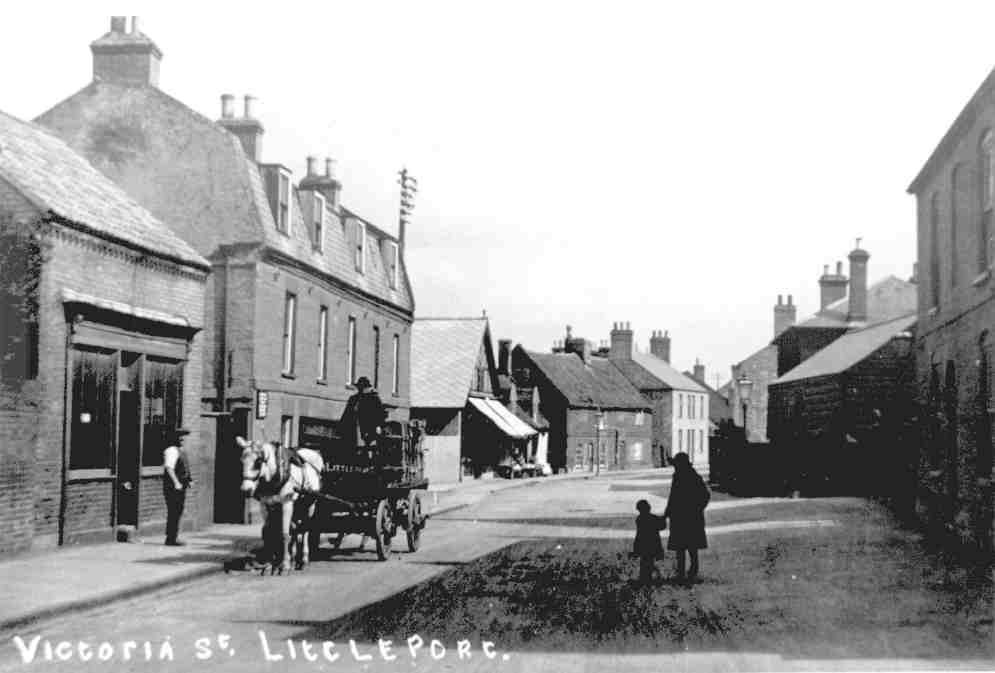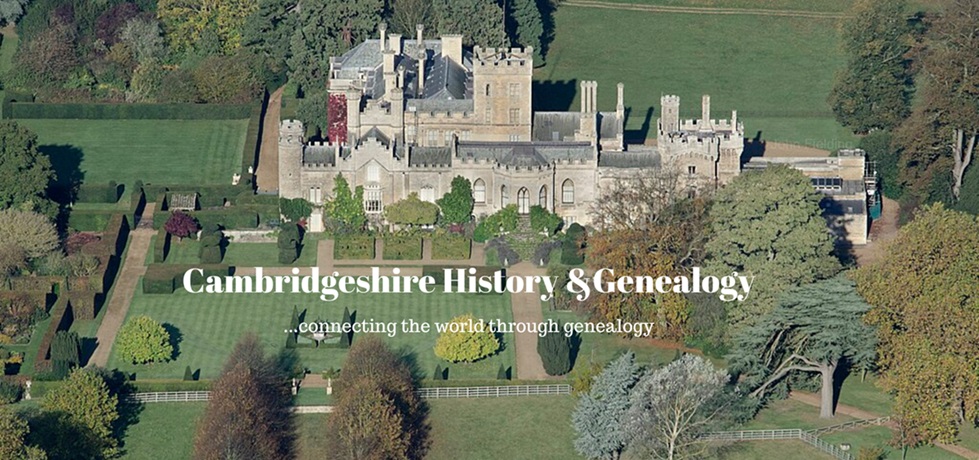LITTLEPORT is a parish and large village, in a fenny part of the Isle of Ely and on the banks of the navigable river Ouse, with a station on the Ely and Lynn section of the London and North Eastern railway, 5 miles north from Ely, 78 from London, in the hundred of Witchford, union, petty sessional division, county court district and rural deanery of Ely, archdeaconry of Wisbech and diocese of Ely. A wrought iron bridge, with one clear opening of 105 feet, was built across the Ouse at this point in 1873, at a cost of £3,700, and there is another iron bridge at Sandhill. The place is lighted with gas from works erected in 1867 by a limited company, on a site given by the Earl of Hardwicke. The church of St. George, an edifice of stone, is a fine example of the Early English style, consisting of chancel, naves, aisles, north and south porches and a lofty embattled western tower containing, a clock and 8 bells hung in 1891: in 1920 a new clock was added, with Cambridge chimes, in memory of the men of the parish who fell in the Great War, 1914-1918; the tower, a conspicuous object throughout the surrounding fen district, is remarkable for the beauty of its outline: the church. was enlarged in 1857 by the addition of a second nave and aisle on the north side: the chancel was restored by Clare College in 1877, a carved stone reredos presented by the Rev. H. J. Carter M.A. curate of Littleport 1860-5 and rector of Duxford 1865-1904: on the north side is a memorial window erected by his widow to the Rev. Andrew Gatenby B.A, for more than 21 years curate in sole charge here and rector of Mepal 1871-6, who died in 1876, in 1891 a new organ and a stained east window were erected as memorials to the Rev. William Bonner Hopkins D.D. hon. canon of Ely, and vicar here 1866-90: in 1895 a stained window was erected and the organ enlarged as a memorial to Mr. William Cutlack, a former churchwarden; it was again enlarged in 1903 at a cost of £350: an inscribed brass has been placed as a memorial to the Rev. Samuel Edgar Perry M.A. vicar 1890-7; in 1898 and 1903 two stained Windows were presented as memorials to William Luddington esq., and his wife, and there is another to Mrs. John Little, of Westlands: a window in the south aisle was presented in 1911 in memory of Mrs. T. J. Mott by T. J. Mott Esq. J.P. and one in the north aisle was given in 1927 in memory of J. Gibson esq. by his widow: a new oak screen was erected in 1904: there are panels, the gift of the Rev. N. W. Shelton M.A. (present vicar) inscribed with the names of the men of this parish who fell in the Great War, 1914-18: there appears to have been formerly a footway from north to south through the tower, used before the drainage of the fens, when the ordinary roads were impassable for foot passengers: there are 872 sittings. The register dates from the year 1606. The living is a vicarage, net yearly value £1,205, with residence, and including 1 acre of glebe, in the gift of the Bishop of Ely, and held since 1916 by the Rev. Norman Wilfrid Shelton M.A. of Trinity College, Dublin, and surrogate. A new vicarage house was erected on the old site in 1892.. About 3,000 acres on the north-east side of the parish were separated from Littleport parish and added to the ecclesiastical district of Little Ouse, Norfolk, Nov. 13, 1866 (full particulars of which will be found in Kelly's Directory of Norfolk).
Littleport St. Matthew is an ecclesiastical parish, formed out of the old parish of Littleport, St. Mary arid Holy Trinity Ely, and Downham in the Isle. July 2, 1878. The church, erected, in 1878 at a cost, including fittings, of about £1,665, from the designs of Mr. W. Bassett Smith, architect, of London, is a structure of brick in the Early English style, consisting of chancel, nave, transepts, south porch and a western turret containing one bell: there are 230 sittings. The register dates from the year 1878. The living is a vicarage, net yearly value £312, with residence arid including 2 acres of glebe and a charge of £20 yearly on the, rectory of Downham, in the gift of the Bishop of Ely, and held since I1925 by the Rev. Frank D'Ynza Bruce. The school church. at Littleport Fen, built in 1869, will seat 120 persons; divine service is held here once every Sunday. The mission room at Ten Mile Bank was erected in 1894, and will seat 120 persons. The Wesleyan chapel, in High street, was erected in 1890 at a cost of £1,700, the old chapel being now used as a Sunday school; there are also Independent, Baptist and Primitive Methodist chapels arid Salvation Army barracks at Littleport, and Wesleyan Methodist chapels at Black Horse Drove, Mildenhall road and Dairy Houses. A cemetery of 5 acres, with mortuary chapel, was formed in 1902, and is under the control of the Littleport Parish Council.
The Town Hall and two Gift Houses adjoining were built in 1879 by the Trustees of the Town Lands Charity, in accordance with the provisions of a scheme framed under an Order of the Charity Commissioners for England and Wales, dated 12th November, 1875. The Alexandra Institute, in Victoria street, erected by Messrs. Hope Brothers Limited for the use of their workpeople, will hold 250; attached is a lending library of about 1,200 volumes, three lawn tennis courts and a garden. The Public Hall, in Hitches street, will hold 500 persons. The Constitutional Hall, in Victoria street, comprises club rooms and a hall holding about 500 persons; the club has over 100 members. The shirt factory of Messrs. Hope Brothers Limited, situated here, was considerably enlarged in 1888, and now employs about 300 hands. A steam fire engine is maintained in the town at the station on Punts hill; the brigade numbers 13.The local charities, of which the Town Lands Charity is the principal, produce a sum of about £200 net yearly, which is distributed in coals and other articles to the poor during the winter. From these charities about 160 acres of land have been appropriated, and let in allotments to parishioners. A large acreage belonging to the County Council and private owners is let out in small holdings. Mrs. J. Spearing and Mrs. W. L. Raynes are ladies of the manor. There are, several landowners. The soil is fen, and subsoil clay; the fen land has been rendered of great value by skilful draining, and also by the system of claying now generally adopted chief crops are sugar beet, wheat, beans, barley, oats, and potatoes. The area is 17,208 acres of land and inland water; the population of the civil parish in 1921 was 4,467, and of the ecclesiastical parishes: - St. George, 3,290 ; St. Matthew, 604.
By the Divided Parishes Act, a portion Hilgay, on the left bank of the river Little Ouse, was amalgamated with this parish in 1885, all the remainder, on the right bank of the river, the property of the late William Luddington esq., going to Southery parish.
 |
LITTLEPORT
Littleport which lies off the Al0 north of Ely seems to have been a rebellious village in earlier times. In June 1638 the Justice of the Peace for the Isle reported that "40 or 50 men gathered in a fen called Whelpmore, near Littlepont...... and that their assembly was appointed to throw down ditches which the drainers had made for enclosing their fen ground from the common, which was left to the inhabitants..." In the same month Sir Miles Sandys of Wilburton was writing to his son at Court describing the tumults and disturbances, and declaring that "If order not be taken it will turn out to be a general rebellion in the fen towns". There was for example "A great riot made at Wickham whilst writing word is brought to me by my Lord of Bedford's workmen, that the country rose up against him both in Coveney and Littleport, by example of the Wickham men".
In more recent times there is the 'Littleport Rebellion' which started on the night of May 22nd 1816 at the Globe Inn. Between 50 and 60 men were present and the talk was of the high prices of wheat and bread. The main grievance was against Henry Martin a leading landowner and farmer. The mob left the inn and stormed through the village breaking windows and smashing furniture and goods. The vicar stood at the door of the vica rage and threatened to shoot the first man who entered. He did not, however, and fled from the house with his family, to walk to Ely, leaving the mob to eat, drink, break or steal whatever they could. The vicar eventually reached Ely and gave the alarm. Troops were brought in to put down the riots which by this time had spread to the surrounding areas such as Downham and Ely on a smaller scale. The operation took many days and as late as June 10th stragglers were being brought in. At the trial 24 were condemmed to death but the sentence was commuted in all but 5 cases.
To the east of the village is 'Burnt Fen' which is traditionally thought to relate to the 'scorched earth' policy of Hereward the Wake.
The Cambridgeshire Fens - BBC Radio Cambridgeshire
Published by Acorn Publications
Research Names for Littleport
|
BANYARD |
BARRETT |
BELL |
BUTCHER |
CARMAN |
CHAPMAN |
CORNWELL |
CRABB |
CRICK |
CROW |
|
DOE |
EASY |
FLETCHER |
FREEMAN |
FYSON |
GASCOYNE |
GENTRY |
GILLETT |
GOODGE |
GOTOBED |
|
GRAY |
HANDLEY |
HARLEY |
HAWKINS |
HODSON |
KEMP |
LOFTS |
MARKLEY |
METCALFE |
MOTT |
|
PALMER |
PECKET |
POPE |
RAYNER |
RHODES |
ROBSON |
ROLPH |
SALMON |
SCOTTING |
SINDALL |
|
SMITH |
SPARROW |
TAYLOR |
THOMPSON |
TITMARSH |
VEAL |
WALKER |
WATSON |
WILKINSON |
WILSON |
|
WILLSON |
